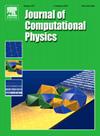An Immersed Boundary Method for pressure-based compressible solvers with applications to free-convection flows, acoustic wave propagation and thermal plasma
IF 3.8
2区 物理与天体物理
Q2 COMPUTER SCIENCE, INTERDISCIPLINARY APPLICATIONS
引用次数: 0
Abstract
Immersed Boundary Methods (IBM) are a practical class of methods that enable fluid computations in complex geometry while keeping a structured mesh. Most of the existing IBM have been developed in the framework of incompressible solvers, despite their significant interest to perform simulations in more complex configurations requiring a compressible solver. In the last years, pressure-based solvers met a growing interest to perform numerical simulations of compressible flows, due to their attractive features, as removing the stability condition on the acoustic time step, and being asymptotically preserving of the incompressible regime when the Mach number tends to zero. As this class of compressible solvers share many common features with classical projection methods for incompressible flows, our objective in this paper is to present an adaptation of an efficient and accurate IBM developed for an incompressible solver by Ng et al. in [1] to a pressure-based compressible solver recently published by Urbano et al. in [2]. The proposed algorithm benefits of the attractive properties of the original IBM proposed in [1] while being able to undertake simulations in much more complex configurations. In particular, we will present validations and illustrations of the proposed solver in various configurations as free-convection flows, acoustic waves propagating in a variable section pipe or interacting with a solid obstacle, as well as the description of a thermal plasma during an electric arc discharge in a gas.
求助全文
约1分钟内获得全文
求助全文
来源期刊

Journal of Computational Physics
物理-计算机:跨学科应用
CiteScore
7.60
自引率
14.60%
发文量
763
审稿时长
5.8 months
期刊介绍:
Journal of Computational Physics thoroughly treats the computational aspects of physical problems, presenting techniques for the numerical solution of mathematical equations arising in all areas of physics. The journal seeks to emphasize methods that cross disciplinary boundaries.
The Journal of Computational Physics also publishes short notes of 4 pages or less (including figures, tables, and references but excluding title pages). Letters to the Editor commenting on articles already published in this Journal will also be considered. Neither notes nor letters should have an abstract.
 求助内容:
求助内容: 应助结果提醒方式:
应助结果提醒方式:


